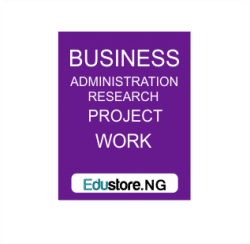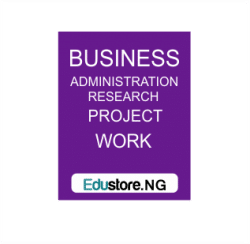ABSTRACT
The focus of this study was on the impact of planning on organizational success. The study shows the linkage between planning and organizational success. The study initiate necessary suggestions and recommendation that could be adopted for efficient performance and productivity of the organization. To accomplish this, five objectives were set out the study was analyze and presented in a tabula form using the research questions, hypothesis based on chi-square method to draw the solution as appropriate. Data were gathered from both primary and secondary source. The total number of population was 100 and 80 respondents were used as sample size. Data analysis and interpretation resulted in the following; that planning is related to organizational success. That planning is very important and essential to every organizational. Based on these findings, conclusion were drawn as followed; planning is essential and must not be taken lightly so as to attain success in the organization.
TABLE OF CONTENTS
Cover page = = = = = = = = = i
Title page = = = = = = = = = = ii
Certification = = = = = = = = = iii
Dedication = = = = = = = == = = iv
Acknowledgement = = = = = = = = v
Abstract = = = = = = = = = = vi
Table of contents = = = = = = = = vii-viii
List of tables and figures = = = = = = = ix
CHAPTER ONE: INTRODUCTION
- Background of the study = = = = = = 1-2
- Statement of the problems = = = = = = 2
- Objectives of the Study = = = = = = 3
- Research Questions = = = = = = = 3-4
- Research Questions = = = = = = = 4-5
- Significance of the study = = = = = = 5
- Scope/Limitation of the Study = = = = = 6
- Historical background of Akwa Ibom Transport = = 6-8
- Definition of terms = = = = = = = 8-9
- Organization of the study = = = = = = = 10
CHAPTER TWO: REVIEW OF RELATED LITERATURE
2.1 Introduction = = = = = = = = 11-12
2.2 Overview of planning = = = = = = = 12-14
2.3 Types of planning = = = = = = = 15-23
2.4 Purpose of planning = = = = = = = 24-26
2.5 principles of planning = = = = = = = 26-29
2.6 planning Processes = = = = = = = 29-33
2.7 Steps in Planning process = = = = = = 34-35
2.8 Problems of panning = = = = = = = 35-38
2.9 Corporate Planning = == == = = = = 38-39
2.10 Planning and organizational success = = = = 40
CHAPTER THREE: RESEARCH METHODOLOGY
3.1 Research Design = = = = = = = = 41
3.2 Area of Study = = = = = = = = 41
3.3 Population of the Study = = = = = = 41
3.4 Sample size and sampling technique = = = = 41-43
3.5 Research Instrument = = = = = = = 44
3.6 Method of Data Collection = = = = = = 44-45
3.7 Method of data Analysis = = = = = = 45-46
3.8 Decision Rule = = = = = = = = = 46-47
CHAPTER FOUR: DATA PRESENTATION, ANALYSIS AND INTERPRETATION
4.1 Data Presentation in Tables = = = = = = 48-57
4.2 Testing of Research Hypothesis = = = = = = 57-62
4.3 Discussion of Findings = = = = = = 62-64
CHAPTER FIVE: SUMMARY, CONCLUSION AND RECOMMENDATIONS
5.1 Summary of Findings = = = = = = = 65
5.2 Conclusion = = = = = = = = = 65-66
5.3 Recommendations = = = = = = = 66-67
References
Appendices
LIST OF TABLES AND FIGURES
Table 4.1.1 Number of questionnaire sent and returned
Table 4.1.2 Category of respondents by sex
Table 4.1.3 category of responded by qualification
Table 4.1.4 Respondent by years of working
Table 4.1.5 Respondent by Age group
Table 4.1.1a Research Question One
Table 4.1.1b Research Question Two
Table 4.1.1c Research Question three
Table 4.1.1d Research Question four
Table 1.1.1e Research Question Five
Table 4.2.1 Testing of research Hypothesis One
Table 4.2.2 Testing of research Hypothesis Two
Table 4.2.3 Testing of research hypothesis three
DOWNLOAD COMPLETE WORK- For Reference Only: Materials are for research, citation, and idea generation purposes and not for submission as your original final year project work.
- Avoid Plagiarism: Do not copy or submit this content as your own project. Doing so may result in academic consequences.
- Use as a Framework: This complete project research material should guide the development of your own final year project work.
- Academic Access: This platform is designed to reduce the stress of visiting school libraries by providing easy access to research materials.
- Institutional Support: Tertiary institutions encourage the review of previous academic works such as journals and theses.
- Open Education: The site is maintained through paid subscriptions to continue offering open access educational resources.






